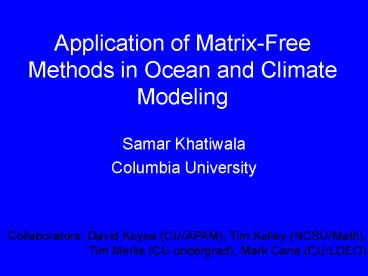Application of MatrixFree Methods in Ocean and Climate Modeling - PowerPoint PPT Presentation
1 / 11
Title:
Application of MatrixFree Methods in Ocean and Climate Modeling
Description:
Collaborators: David Keyes (CU/APAM), Tim Kelley (NCSU/Math) ... Graph coloring methods for efficient Jacobian evaluation. Multigrid, coarse-graining ... – PowerPoint PPT presentation
Number of Views:40
Avg rating:3.0/5.0
Title: Application of MatrixFree Methods in Ocean and Climate Modeling
1
Application of Matrix-Free Methods in Ocean and
Climate Modeling
- Samar Khatiwala
- Columbia University
Collaborators David Keyes (CU/APAM), Tim Kelley
(NCSU/Math), Tim Merlis
(CU undergrad), Mark Cane (CU/LDEO)
2
Solving A x b
- 2 classes of methods to do this
- Direct methods
- - storage and direct manipulation of the
elements of A - - exact solution
- - good for small, dense problems
- Iterative methods
- - approximate solution
- - good for large, sparse problems
- - KRYLOV SUBSPACE METHODS
- - DONT NEED TO KNOW A
- - ONLY REQUIRE ABILITY TO COMPUTE
- MATRIX-VECTOR PRODUCTS, i.e., Ax
Ax
Matrix-Free
x
yAx
3
Some applications
- Finding fixed points and limit cycles of large
dynamical systems (e.g., ocean GCM) - Linear stability and bifurcation analysis
- Parameter sensitivity
- Obtaining compact/reduced dimension
representations of complex models - Probing and analyzing complex systems defined
through a (legacy) time-stepper - Empirical parameterization of unresolved physics
(e.g., spatial variations in eddy-diffusivity)
4
Efficient computation of equilibrium solutions of
seasonally forced ocean GCMs
- Ocean and climate models driven by
time-independent or periodic (seasonal) forcing - Very desirable to obtain equilibrium solutions
(e.g., for initializing climate change
simulations, parameter sensitivity studies, etc)
5
Current practice
- Direct forward integration until transients have
died out - If the transients disappear after a few periods,
this is the simplest and most efficient approach - HOWEVER
- Time scale for dynamical adjustment of the ocean
is very long (several 1000s of years) - Serious computational challenge in climate
modeling
6
Matrix-Free Newton-Krylov Approach
- GCM time stepper
- u(t) F(u(0),t)
F RN RN
state transition function
model state at time t
N O(106)
Steady-state formulation F(u) u - F(u,T) 0
- Nonlinear algebraic system - T is the (known)
forcing period - System is nonautonomous so
solution is unique
7
How to solve F(u)0?
- Newtons method
- Starting with initial guess u0
- repeat for k0,1,
- (1) solve J(uk)duk -F(uk), J?F/?u
- (2) uk1 uk duk
Linear system of equations!
- - J is a DENSE matrix, impossible to store or
compute - Use a Krylov method to solve the linear system
- Only need to be able to evaluate F, i.e.,
- integrate the GCM
8
Initial results from an ocean GCM
- MIT OGCM, sector configuration (2 resolution)
- Seasonally forced
- N 40000
Recomputation of approximate preconditioner
9
Key challenge Matrix-free preconditioning
- PC via time stepper map which has better
preconditioning than original problem (EV
clustering) - PC using sparse representation of model
advection-diffusion operator and fast (Krylov)
methods for matrix exponential calculation - AD implicit time stepping of coarse grained
problem - Graph coloring methods for efficient Jacobian
evaluation - Multigrid, coarse-graining
- Problem scaling, globalization of Newton
10
Linear stability analysis of a global ocean GCM
MIT GCM Wrapper ARPACK
11
Temperature eigenvectors associated with
smallest Eigenvalue (gravest eigenmode)































